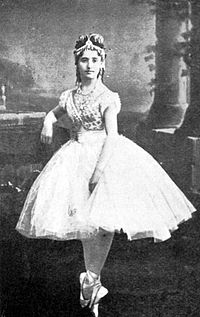Coppélia
| Coppélia | |
|---|---|

Giuseppina Bozzacchi as Swanhilde in the Saint-Léon/Delibes Coppélia. Paris, 1870
|
|
| Choreographer | Arthur Saint-Léon |
| Music | Léo Delibes |
| Based on | Der Sandmann by E. T. A. Hoffmann |
| Premiere | 25 May 1870 Théâtre Impérial l'Opéra, Paris |
| Characters | Doctor Coppélius Swanhilda Franz |
| Genre | Romantic |
| Type | Comic ballet |
Coppélia is a comic ballet originally choreographed by Arthur Saint-Léon to the music of Léo Delibes, with libretto by Charles-Louis-Étienne Nuitter. Nuitter's libretto and mise-en-scène was based upon two stories by E. T. A. Hoffmann: Der Sandmann (The Sandman) and Die Puppe (The Doll). In Greek, κοπελιά means girl, young lady. Coppélia premiered on 25 May 1870 at the Théâtre Impérial l'Opéra, with the 16-year-old Giuseppina Bozzacchi in the principal role of Swanhilde. The costumes were designed by Paul Lormier and Alfred Albert, the scenery by Charles-Antoine Cambon (Act I, scene 1; Act II, scene 1), and Édouard Desplechin and Jean-Baptiste Lavastre (Act I, scene 2).
The ballet's first flush of success was interrupted by the Franco-Prussian War and the Siege of Paris (which also led to the early death of Giuseppina Bozzacchi, on her 17th birthday), but eventually it became the most-performed ballet at the Opéra.
Modern-day productions are traditionally derived from the revivals staged by Marius Petipa for the Imperial Ballet of St. Petersburg in the late 19th century. Petipa's choreography was documented in the Stepanov method of choreographic notation at the turn of the 20th century. These notations were later used to stage the St. Petersburg version for such companies as the Vic-Wells Ballet (precursor of today's Royal Ballet).
...
Wikipedia
